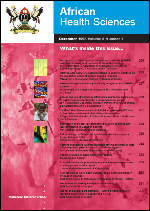
|
African Health Sciences
Makerere University Medical School
ISSN: 1680-6905
EISSN: 1680-6905
Vol. 15, No. 4, 2015, pp. 1256-1261
|
 Bioline Code: hs15172
Bioline Code: hs15172
Full paper language: English
Document type: Research Article
Document available free of charge
|
|
|
African Health Sciences, Vol. 15, No. 4, 2015, pp. 1256-1261
| en |
Effects of treatment on free radicals in patients with pulmonary tuberculosis in South Western Nigeria.
Adebimpe, Wasiu Olalekan; Faremi, Ayodeji Oluwaseun & Nassar, Sulaiman Adebayo
Abstract
Background: Formation of Malondialdehyde (MDA), a free radical, in Tuberculosis patients does occur when Tubercule
bacilli induces reactive oxygen species as a result of phagocytic respiratory burst.
Objectives: This study evaluated the effect of treatment on plasma level of Malondialdehyde among patients infected with
Mycobacterium Tuberculosis in Osogbo South Western Nigeria.
Methodology: Descriptive cross sectional study among 110 patients, grouped into four categories (three TB patient categories
and controls). All patients were screened for presence or absence of Mycobacterium tuberculosis in their sputum and
HIV 1 & 2 in their blood using standard techniques. The level of free radical (Malondialdehyde, MDA) was determined by
Thiobabituric acid reacting method. Data was analyzed using the SPSS software version 17.0
Results: Serum Malondialdehyde (MDA) levels were significantly lower in TB patients on drugs (TBD) compared with the
new cases on treatment (NCT). (0.17+0.88mol/L Vs 0.27+0.08mol/L, p<0.05). Varying degrees of correlations were also
found between free radicals and electrolytes.
Conclusion: Reduced serum MDA levels in TBD suggested a reduction in the levels of free radical injury once treatment
was commenced. Therefore serum free radical may be an index of monitoring response to treatment in tuberculosis management.
Keywords
Free radicals; malondialdehyde (MDA); mycobacterium tuberculosis; reactive oxygen species; tubercule bacilli; electrolytes
|
| |
© Copyright 2015 - African Health Sciences
|
|
